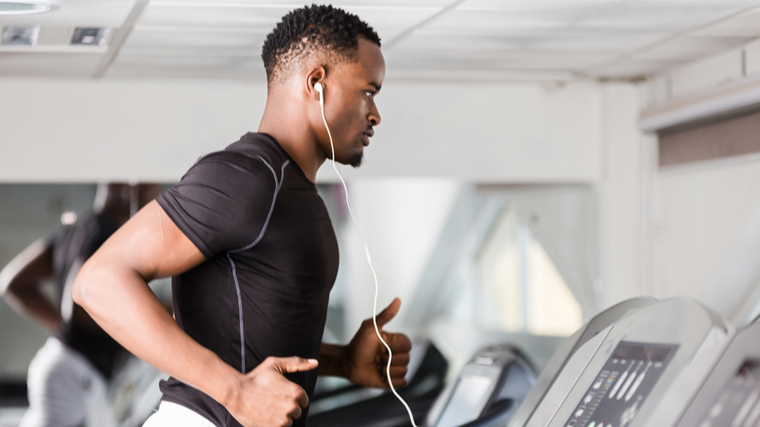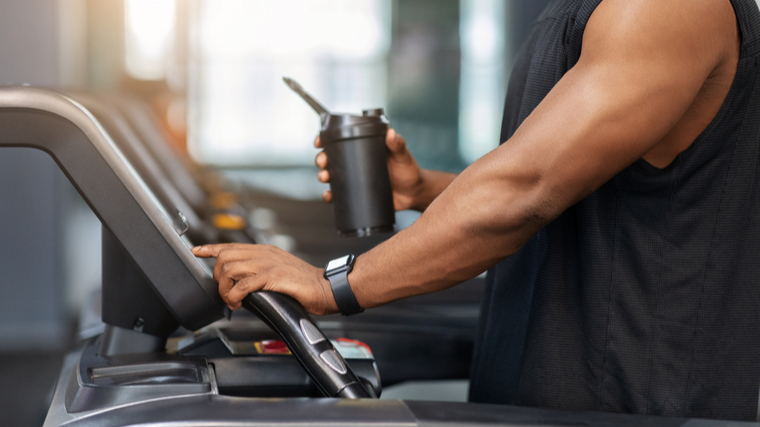So Is Fasted Cardio Worth It or Nah? (original) (raw)
- What is Fasted Cardio?
- |
- Does Fasted Cardio Work?
- |
- Potential Benefits
- |
- Fasted Cardio Myths
- |
- Should You Try Fasted Cardio?
Your time at the gym can be dictated by a lot of different things. Sometimes, you want to improve your mental health, have a good time, or focus on making your body stronger. Other times, you have more competition or image-oriented goals like gaining muscle mass or losing body fat.
Throughout a lifter’s training life, they might try out different fad diets in an effort to lose body fat. Your gym buddies might swear by different types of fasting, like intermittent fasting or fasted cardio, when they’re looking to lose body fat.

Credit: Samuel Borges Photography / Shutterstock
If you work out very early in the morning, want to avoid cramps from working out on a full stomach, or just aren’t a breakfast person, you might decide to give fasted cardio a try. But what exactly is fasted cardio? And does it actually benefit your training?
It may seem taboo to exercise without fueling your body first, but if you’re working out before the sun comes up, you might just choose to do just that. Fasted cardio refers to pumping out an aerobic workout without food in your system — so your body is in a fasted state. Any food that you had eaten prior to training has already been processed and digested.
Come morning time after you haven’t eaten all night, your glycogen levels are low. You might be able to use body fat as fuel more readily when you have low glycogen levels. (1) Some researchers have suggested that this might contribute to weight loss. (2)
When Can You Do Fasted Cardio?
When you think about fasted cardio, early morning workouts often come to mind first. That’s because your body digests the previous day’s food overnight. But you can perform a fasted cardio session no matter what time you work out. If you skipped lunch at work or are doing intermittent fasting, you can perform fasted cardio later in the afternoon.

Credit: P Stock / Shutterstock
Depending on how fast your body digests food, you may need to eat no less than four to eight hours before exercising to reap the benefits of fasted cardio. Exercising consistently, eating probiotic-rich foods like yogurt, and drinking enough water can help improve digestion to help this process along. (3)(4) If you’re interested in trying fasted cardio, experiment a little to find what specific timing works best for your body.
Does Fasted Cardio Work?
Every body is different, and what may work for your body may not work for your gym partner. But fasted cardio does have the potential to be effective when used properly. The theory of fasted cardio is that your body will use stored fat as energy as opposed to carbohydrates, which might help reduce body fat. Carbohydrates are the body’s main source of energy, so when none are readily available, it has to pull from somewhere else for fuel. (1)(2)
The theory sounds simple enough. But the proverbial jury is out as to whether or not it is actually effective. One study suggests that, all things being equal in your actual workout, exercising fasted or fed doesn’t make a difference to your body composition. (5) However, another study suggests that fasted cardio can aid in weight loss and body fat. (6)

Credit: LightField Studios / Shutterstock
Research shows that fasting can cause low levels of insulin and hepatic glycogen. So when you perform cardio during this time, you might utilize more fat for energy — which is one of the things it’s there for. (7) This means that fat that is typically stored is being used and “burned,” which can result in body fat loss.
Generally, the ideal way to use fasted cardio is with steady-state cardio, such as jogging, for 30 minutes to an hour. Doing more strenuous training, like working with heavy barbells, often requires more fuel in your system.
If you choose to do a higher-intensity workout, it shouldn’t be as long as it would be when you’ve had a pre-exercise meal. The idea is to maximize your gains, rather than risking hurting yourself by depriving yourself of the fuel you need and pushing yourself beyond what your body can do safely.
Potential Benefits of Fasted Cardio
Working out early in the morning is difficult enough, not to mention needing to wake up early enough to grab breakfast and digest it before getting started. But that’s not the only potential benefit of fasted cardio.
Less Exercise-Induced Nausea
Gastrointestinal symptoms like nausea and vomiting can happen a lot for athletes. Up to 83 percent of marathon runners and 70 percent of general athletes may experience it. (11) Although these symptoms might not be too severe, you probably want to avoid nausea and cramps if you can. Exercise-induced nausea might be worse when you eat before your workout. (12) By practicing fasted cardio, you may reduce the risk of your stomach rebelling mid-session.
Improves VO2 Max
VO2 max refers to the amount of oxygen your body uses during intense exercise. A higher VO2 max is generally associated with greater physical performance. When you perform fasted cardio periodically, you have the potential to improve your VO2 max over time. Fasted training can also improve peak power, or the greatest production of work, compared to training when you’ve already eaten. (13)
Saves Time in the Morning
There’s nothing wrong with grabbing a snack or even totally fueling up before your workout. But if eating in the morning makes you queasy — or if you don’t want to wake up even one second earlier than you have to — chances are you’ll avoid eating before a morning training session. Plus, you won’t have all that much time to feel those hunger pangs and can look forward to a solid breakfast after training.

Credit: Prostock-studio / Shutterstock
For those reasons, fasted cardio seems to be more popular in the morning. If you’re an early riser and want to hit the gym by five in the morning, you may find that fasted cardio can save you some time. It reduces the time you would normally need in the morning to get breakfast ready and digest it before working out.
Fits With Intermittent Fasting
Intermittent fasting is a pattern of eating within certain time constraints. A popular cycle is 16/8, which means you eat only within an eight hour period — such as between 12 p.m. and 8 p.m. — and fast for the other 16 hours.
If you’re looking to specifically lose body fat, intermittent fasting may be one way to do that. (10) And since you’re already fasting at certain times, it can make fasted cardio more convenient to fit in.
Burn More Fat
Burning more fat may be on your list of goals, and if so, fasted cardio could be a good option. Some research suggests that eating before and even during low- and moderate-intensity exercise doesn’t always significantly interfere with fat oxidation, or fat “burning.” (8) But other studies suggest that exercising in a fasted state can burn more fat than in a fed state. (9)
Fasted Cardio Myths
Burning more fat while saving time in the morning might sound great if you’re not a breakfast fan and you want to reduce your body fat. But although fasted cardio can provide several benefits, don’t believe everything you hear. There are myths behind this method that you should be aware of before trying fasted cardio.
Myth: Fasted Cardio is Safe and Sustainable
Research Shows: Fasted cardio can be a symptom of, or lead to, disordered eating behaviors.
Although fasted cardio might seem like a simple solution to a difficult problem — that is, struggling to lose body fat — research suggests that combining fasting with exercise might do more harm than good. Fasting to avoid weight gain or to promote weight loss is a known predecessor and symptom of anorexia nervosa. (14) And when you choose to exercise in a fasted state specifically to lose weight or body fat, you’re less likely to develop healthy eating habits and positive body image. (15)

Credit: IZE-5tyle / Shutterstock
Using fasting and exercise to compensate for not feeling great about your body — particularly with the goal of losing weight — has been shown to be linked to depression, low self-esteem, and much higher risk of developing disordered eating habits. (16)(17)(18)
Myth: Fasted Cardio Improves Performance
Research Shows: Frequently performing fasted cardio negatively impacts workouts.
This method can be beneficial every now and then, but it doesn’t seem to be sustainable long-term. It could even be detrimental to your performance or weight loss goals. Using fat for fuel is not ideal for longer, more strenuous workouts. Performing fasted workouts regularly have been shown to negatively impact exercise intensity and length. (19) Performing fasted cardio once or twice per week at a low- to moderate-intensity might then be more ideal for maintaining performance and weight loss goals.
When your body has lower insulin levels — as when exercising without food in your system — you’ll often wind up with less energy. This is why it’s important to listen to your body and figure out a food and exercise strategy that feels good to you. Lower energy levels are likely to hinder your performance and force you to significantly shorten your exercise time. (20)
Myth: Fasted Cardio is the Best Way to Lose Weight
Research Shows: Fasted cardio may not be more effective than fed cardio at promoting fat loss or weight loss.
Yes, fasted cardio may increase your potential to burn more fat when exercising. But it may not necessarily lead to weight loss.
Weight loss and fat loss are two different things. Weight loss refers to actually losing pounds from fat, muscle, or water. Fat loss refers to reducing fat mass. The latter is a more specific goal and may not result in overall weight loss.

Credit: GaudiLab / Shutterstock
Still, fasted cardio is not the end-all-be-all when it comes to fat loss. Fasted cardio may not have a bigger impact on your body composition than regular cardio. (5)(8) Plus, using fasted cardio too much can harm your performance. (19) That may well loop back and negatively affect any weight loss goals you might have.
Should You Try Fasted Cardio?
Do you feel more energized at 4 a.m. with just some water and a cup of coffee than you do with breakfast in your belly? Sweet. If you can get through some cardio without feeling light-headed, fasted cardio a couple times a week might be for you. On the other hand, if you know you’re already struggling with disordered eating habits or you get woozy on an empty stomach, there’s no reason to skip your pre-workout meal.
If you’re new to the gym, you may want to steer clear of fasted cardio — at least at first. As you train longer, you’ll learn more about how your body adapts to specific kinds of exercise stressors. The longer you train, the more you learn about how your body responds to exercise under different conditions. That way, you can make a more informed decision about fasted cardio. That said, if you’re eager to roll out of bed, lace up your sneakers, and get out on a run, try a low-intensity 15 to 30-minute jog to see how your body feels.
Folks with diabetes, people who are pregnant, or experiencing other medical conditions that may cause low blood sugar will likely want to consult a doctor before experimenting with fasted cardio.
Regardless of your health or fitness experience level, start slow if you’re trying fasted cardio for the first time. Make sure you have snacks on hand just in case. Dizziness or lightheadedness could be a sign of low blood sugar. Typically, you can make the spinning stop with a snack like an apple or a sports drink.
Go Fast (Or Not)
If cardio is a part of your typical routine, the question probably has arisen more than once for you — is it alright to run or work out on an empty stomach? Ultimately, it’s a personal choice whether fasted cardio is right for you. There’s a lot of contradicting and inconclusive research on fasted cardio, so knowing your health history and the possible risks — and potential benefits — is important for ensuring your safety and your gains.
References
- Escalante, Guillermo, Barakat, Christopher. Fasted Versus Nonfasted Aerobic Exercise on Body Composition: Considerations for Physique Athletes. Strength and Conditioning Journal. 2020; 42(5).
- Batch, Jennifer T., Lamsal, Sanjay P., & Adkins, Michelle. Advantages and Disadvantages of the Ketogenic Diet: A Review Article. Cureues. 2020; 12(8).
- Oettle, G J. Effect of Moderate Exercise on Bowel Habit. Gut. 1991; 32(8).
- Elli, Marina, Callegari, Maria Luisa, & Ferrari, Susanna. Survival of Yogurt Bacteria in the Human Gut. Applied and Environmental Microbiology. 2006; 72(7).
- Schoenfeld, Brad Jon, Aragon, Alan Albert, & Wilborn, Colin D. Body composition changes associated with fasted versus non-fasted aerobic exercise. Journal of International Society of Sports Nutrition. 2014; 11. doi: 10.1186/s12970-014-0054-7
- Zouhal, Hassane, Saeidi, Ayoub, & Salhi, Amal. Exercise Training and Fasting: Current Insights. Open Access Journal of Sports Medicine. 2020; 11.
- Vieira, Alexandra Ferreira, Costa, Rochelle Rocha, & Macedo, Rodrigo Cauduro Oliviera. Effects of aerobic exercise performed in fasted v. fed state on fat and carbohydrate metabolism in adults: a systematic review and meta-analysis. Cambridge University Press. 2016.
- Horowitz, J F, Mora-Rodriguez, R, & Byerley, L O. Substrate metabolism when subjects are fed carbohydrate during exercise. The American Journal of Physiology. 1999; 276(5).
- Gonzalez, Javier T., Veasey, Rachel C., & Rumbold, Penny L.S. Breakfast and exercise contingently affect postprandial metabolism and energy balance in physically active males. Cambridge University Press. 2013.
- Welton, Stephanie, Minty, Robert, & O’Driscoll, Teresa. Intermittent Fasting and Weight Loss. Canada Family Physician. 2020; 66(2).
- Samborski, Pawel, Chmielarz-Czarnocińska, Anna, Grzymisławski, Marian. Exercise-Induced Vomiting. Przegląd Gastroenterologiczny. 2013; 8(6).
- Kondo, T, Nakae, Y, & Mitsui, T. Exercise-induced nausea is exaggerated by eating. Science Direct. 2001; 36(2).
- Stannard, Stephen R., Buckley, Alex J., & Edge, Johann A. Adaptations to Skeletal Muscle with Endurance Exercise Training in the Acutely Fed Overnight-Fasted State. Journal of Science and Medicine and Sport. 2010; 13(4).
- Lloyd EC, Haase AM, Zerwas S, Micali N. Anxiety disorders predict fasting to control weight: A longitudinal large cohort study of adolescents. Eur Eat Disord Rev. 2020 May;28(3):269-281.
- Panão I, Carraça EV. Effects of exercise motivations on body image and eating habits/behaviours: A systematic review. Nutr Diet. 2020 Feb;77(1):41-59.
- Lepage ML, Crowther JH, Harrington EF, Engler P. Psychological correlates of fasting and vigorous exercise as compensatory strategies in undergraduate women. Eat Behav. 2008 Dec;9(4):423-9.
- Davis HA, Guller L, Smith GT. Developmental trajectories of compensatory exercise and fasting behavior across the middle school years. Appetite. 2016 Dec 1;107:330-338.
- Chapuis-de-Andrade S, de Araujo RM, Lara DR. Association of weight control behaviors with body mass index and weight-based self-evaluation. Braz J Psychiatry. 2017 Jul-Sep;39(3):237-243.
- Terada, Tasuku, Toghi Eshghi, Saeed R., & Liubaoerjijin, Yilina. Overnight fasting compromises exercise intensity and volume during sprint interval training but improves high-intensity aerobic endurance. The Journal of Sports Medicine and Physical Fitness. 2019; 59(3).
- Aird, T.P, Davies, W., Carson, B.P. Effects of fasted vs fed-state exercise on performance and post-exercise metabolism: A systematic review and meta-analysis. Scandinavian Journal of Medicine & Science in Sports. 2018.
Featured Image: Samuel Borges Photography / Shutterstock